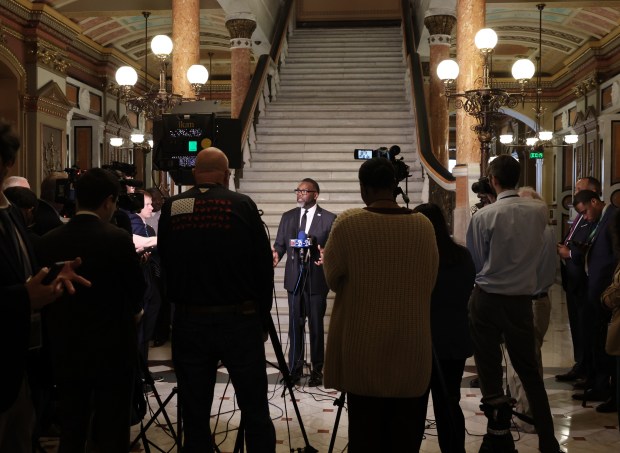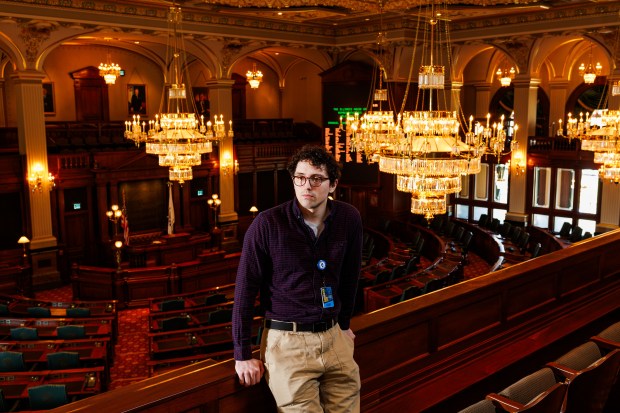SPRINGFIELD — With Gov. JB Pritzker still weighing whether to seek a third term, the firmer foundation he’s laid for Illinois’ historically shaky finances faces a major stress test from ballooning deficit projections, increased spending pressures and uncertainty over federal assistance with President Donald Trump back in the White House.
Ahead of his Feb. 19 budget speech, Pritzker is staring down a hole that his administration pegged in November at more than $3 billion, a gap expected only to widen in future years if Pritzker and his Democratic allies in the legislature don’t take steps to rein in spending or raise taxes. It could prove to be a legacy-defining moment for a politically ambitious governor who has made strong fiscal stewardship a cornerstone of his identity, even as the state’s operating budget has grown by nearly a third during his tenure, to $53.1 billion. (Adjusting for recent high inflation, the increase is a more modest 8%.)
The challenges Pritzker faces are myriad: mandated increases in funding for schools and pensions; a negligible increase in revenue; a misstep in previous tax disbursements; and ambitious health care funding plans coupled with rising medical costs.
There will also be pressure for new spending, including requests from Chicago for help fixing longstanding financial problems at the CTA and Chicago Public Schools that have been exacerbated by the depletion of federal COVID-19 relief funds. In addition, public employee unions and some fellow Democrats are pushing to boost the less-generous pension benefits received by state workers, teachers and others hired since 2011.
The governor has publicly acknowledged the stakes facing his administration and the state.
“If we balance the budget again this year, I believe people will finally see that Illinois can govern itself,” Pritzker said last week at an unrelated news conference in Springfield.
He also emphasized the importance of living “within our means in this state and that we not resort to tax increases” to balance the budget.
Pritzker’s budget proposal will kick off months of wrangling among the administration and lawmakers, a process in which pressure will ramp up as some in the Democratic supermajorities in the House and Senate push for more money for the programs and causes they support.
To be sure, deficit projections can change over time. Amid the depths of the pandemic in late 2020, for example, the Pritzker administration projected a nearly $4 billion deficit for the next budget year. By the time the governor delivered his spending proposal in February 2021, the forecast hole had shrunk to $2.6 billion because of a variety of factors. The administration would not say whether the size of next year’s expected gap has changed since the projections two months ago.
Nevertheless, observers anticipate one of the toughest budget seasons of Pritzker’s tenure.
“The state is better situated than the city or CPS by comparison, but this is the beginning of where we actually have to start to do the hard work of right-sizing the budget relative to our actual revenue streams,” said Joe Ferguson, president of The Civic Federation, a nonpartisan budget watchdog.
After years of stronger-than-expected income and sales tax revenues, in large part the result of a growing economy turbocharged by federal stimulus payments, the amount of money flowing to the state is returning to normal levels. It’s a national trend that the nonpartisan Pew Charitable Trusts in a report last year dubbed “the revenue wave.”
In Illinois, revenue growth that exceeded pre-pandemic trends accounted for more than three-quarters of the new money the state collected from 2020 through 2022, among the highest percentages in the country, according to Pew.
Now, projected sales tax revenues are down, and other revenue streams are expected to remain relatively flat, putting the overall revenue increase at about $1 billion, according to state projections.
At the same time, the state faces mandated increases in both contributions to the state’s pension systems, which together face unfunded liabilities of $144 billion, and funding for elementary and secondary education.
“The real reason for the gap comes on the expenditure side, and that’s a combination of both regular, sort of scheduled, mandated things” as well as “more discretionary” spending, said The Civic Federation’s Ferguson.
Pritzker is expected to call for boosting money for schools by the mandated minimum of $350 million and devoting an additional $75 million to his multiyear plan to add 20,000 seats to state-funded preschool programs by the end of his second term.
In its November report, the governor’s budget office also pointed to pressure from continued inflation in medical costs and “moderate growth rates in the various categories of state spending.”
Another challenge stems from previous overpayments of certain tax revenues to local governments as a result of unanticipated consequences of a state tax law enacted in response to provisions in Trump’s 2017 tax cuts, said Natalie Davila, a public finance economist who has worked with the Illinois Municipal League and previously as director of economic and tax policy research at the state Department of Revenue.
To correct those overpayments, the state held back about $1.6 billion from municipalities last budget year and additional funds this year, providing temporary boosts to state revenue that won’t be repeated in the coming year, Davila said.
Dealing with that issue is “not going to be a problem, per se,” she said, but making sure future projections are correct will be complicated with both the Trump tax law and the state law at issue set to expire this year.
On the expenditures side, a portion of the projected increase in health care spending is likely from the state’s Medicaid-style program for immigrants who are in the country without legal permission, said Ralph Martire, executive director at the Center for Tax and Budget Accountability.
The program costs ballooned, and the issue has roiled the General Assembly in recent years, with Pritzker taking steps in 2023 to contain costs by curtailing enrollment.
But no single issue accounts for the entire increase in expected spending, and the public projections so far don’t account for many of the top-of-mind political issues likely to drive the debate this spring.
Chicago-area mass transit, including the CTA, Metra commuter rail and the Pace suburban bus service, faces a $771 million cliff in 2026 with the impending end of federal pandemic relief, and some lawmakers have proposed spending more than $1 billion to transform the system.
There’s also pressure from City Hall to help address funding woes at CPS amid tense contract negotiations with the Chicago Teachers Union, Mayor Brandon Johnson’s closest political ally.
Those potential requests would come as the often fractious relationship between Pritzker and Johnson is perhaps at its nadir after the two butted heads in early January over a Pritzker-backed plan to regulate intoxicating hemp-derived products. In uncharacteristically blunt comments, Pritzker criticized Johnson over the mayor’s poor relationships in Springfield.
There’s also a contingent of Democrats in Springfield pushing to address a growing concern that pension plans for more recently hired public employees, who don’t receive Social Security in retirement, might not meet minimum benefits required by the federal government.
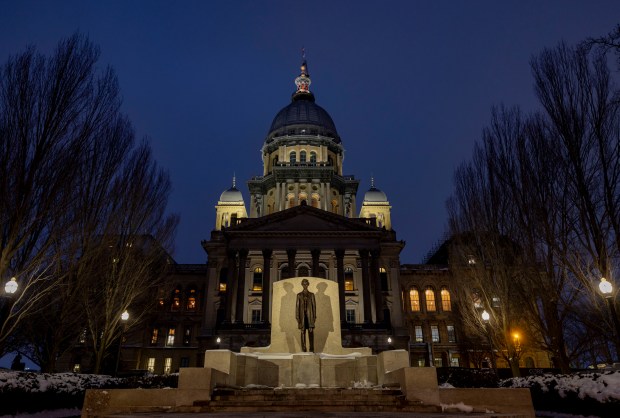
While one path for bringing the so-called Tier 2 pension plans in line with Social Security was estimated to cost around $5.6 billion over about two decades, a union-backed proposal last year to boost benefits even more would have cost closer to $30 billion over that time frame, according to two reports from the legislature’s bipartisan forecasting commission.
“That’s not chump change, and it has to be fixed,” Martire said.
But in his remarks to reporters last week, Pritzker made clear that the larger pension package was not on his agenda.
“Whatever it is that we do on the pension system has to be within the context of making sure that we’re improving our credit,” said Pritzker, who routinely trumpets the state’s first credit rating upgrades in decades under his watch. “And if you think credit ratings don’t matter, let me tell you, hundreds of millions of dollars gets spent in the interest payments if we don’t get that right.”
Looming over all those issues is the uncertainty introduced by the second Trump administration, which was brought into high relief last week when the White House Office of Management and Budget issued a directive freezing federal funds in a number of areas and Illinois and other states were subsequently unable to access federal Medicaid funds.
Amid backlash, the Trump administration rescinded the directive, and Pritzker said it appeared Illinois has gotten back its access to federal funds. But he said the tumultuous turn of events served as a reminder of what Trump’s policies could mean for Illinois’ finances.
“We have partnerships that have been in existence for half a century or more on some of these major important programs that are necessary for middle-class families, working-class families, the most vulnerable in our state. So, it’s hard to plan for devastation, which is what it would be,” Pritzker said. “We’re doing our best to put together a budget that is balanced. We’re doing our best to think about the contingencies that we might have to have as eventualities because of what we think might be coming from the Trump administration.”
Most rank-and-file lawmakers are waiting to see how Pritzker proposes to close the projected budget hole.
State Rep. Fred Crespo, a Democrat from Hoffman Estates, said he’s concerned that there are few options left to address the gap after Democrats in the House and Senate last year approved a tax hike package of some $750 million to balance the current budget. The package included a contentious move to raise taxes on sportsbooks.
Crespo suggested during budget talks last spring that the state hold off on some of the increases for “when we really need them.”
“And now we used them up. So what tools do we have available?” Crespo said. “Not very many.”
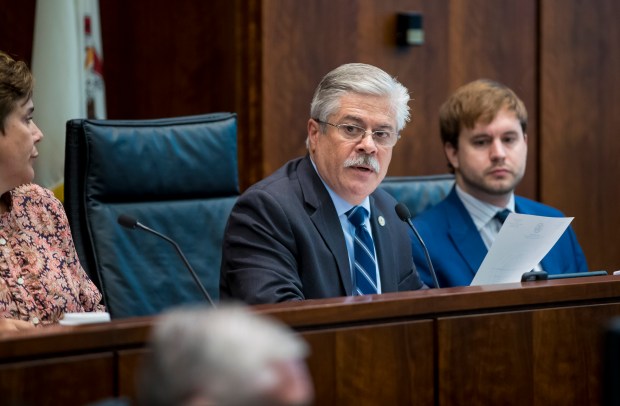
In an interview on a Sun-Times podcast last month, House Speaker Emanuel “Chris” Welch said the focus should be on finding “efficiencies” — a byword for “cuts” — rather than potential tax increases, nodding to the economic anxiety that had a role in Republicans’ strong showing nationally in November’s election.
“The last thing people want to hear around the kitchen table is the speaker of the House talking about tax increases,” said Welch, a Hillside Democrat. “I think that would be tone-deaf to what we heard in November.”
Holding the line likely will require a willingness to say “no” to the wish lists of Welch’s 78-member Democratic caucus, and likewise for Senate President Don Harmon of Oak Park with the 40 Senate Democrats.
“People are going to have personal or member initiative things that are really important to them,” said Rep. Kam Buckner, a Chicago Democrat recently tapped by Welch to help lead budget negotiations. “But I think we all recognize that when we come to these jobs we represent a district, but we legislate for an entire state.”
“At the end of the day, this needs to be a budget that is done right,” Buckner said. “A budget that is done right means schools stay open, roads get fixed, public transit works and working families get a fair shot without overburdening taxpayers.”
State Sen. Chapin Rose, the Senate GOP’s chief budget negotiator, pointed to hundreds of millions of dollars in increased taxes in recent years that have supported increased spending, and he argued that federal pandemic relief helped mask underlying deficiencies in the state’s budget and economy.
“They, being the progressive left Democrats that run Illinois, they’re just sort of incapable of not spending money,” Rose, of Mahomet, said in an interview with the Tribune. “You and I look at our pocketbooks and we’re sort of constrained in the grocery store by how much money’s in our pocketbook, right? They load up their grocery cart before they ever look in their pocketbook.”
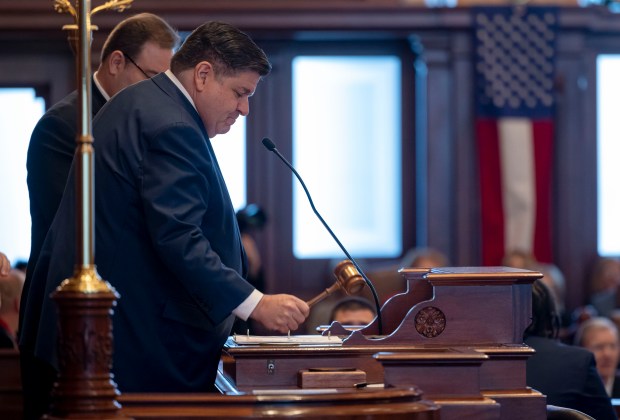
House Republican leader Tony McCombie also accused Democrats of excessive spending.
“The Democrats say this is a moral document. Absolutely it is. But that being said, it shouldn’t be filled with pork projects. Maybe we don’t get to do that. Maybe we don’t get to spend that extra money for a while,” said McCombie, of Savanna. “Maybe we should be getting down to some structural reform.”
Among those watching the budget process closely will be Eric Kim of Fitch Ratings, one of the firms that has upgraded the state’s credit in recent years. In many ways, the situation facing Illinois this year is to be expected, Kim said.
“It’s normal for states to start budget seasons with projected deficits — the situation we’ve seen in recent years with big revenue surpluses is what’s unusual,” he wrote in an email.
“It’s going to be tougher to get a budget done this spring,” Kim added. “In assessing the final budget, our focus is going to be on the choices the state makes — will the enacted budget rely on recurring solutions that are sustainable or does Illinois revert to one-shot, short-term fixes? Our recent upgrades to the state and the current stable outlook reflect our view that, particularly with a national economy that is still steadily growing, Illinois should be able to make prudent, long-term fiscal choices.”
Chicago Tribune’s Addison Wright contributed. Olander and Petrella reported from Chicago.


